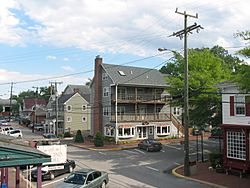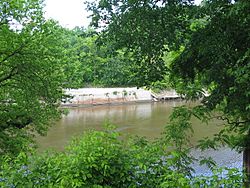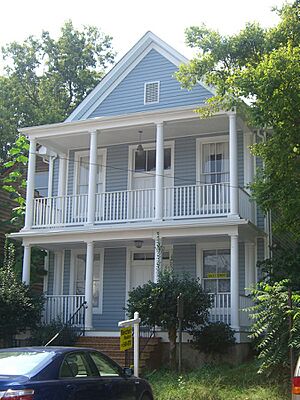Occoquan, Virginia facts for kids
Quick facts for kids
Occoquan, Virginia
|
|
|---|---|
| Town of Occoquan | |

Mill Street, the center of Occoquan's historic and commercial district
|
|

Location in Prince William County and the state of Virginia.
|
|
| Country | |
| State | |
| County | Prince William |
| Area | |
| • Total | 0.22 sq mi (0.57 km2) |
| • Land | 0.17 sq mi (0.45 km2) |
| • Water | 0.05 sq mi (0.12 km2) |
| Elevation | 7 ft (2 m) |
| Population
(2010)
|
|
| • Total | 934 |
| • Estimate
(2019)
|
1,086 |
| • Density | 6,277.46/sq mi (2,423.69/km2) |
| Time zone | UTC−5 (Eastern (EST)) |
| • Summer (DST) | UTC−4 (EDT) |
| ZIP code |
22125
|
| Area code(s) | 703, 571 |
| FIPS code | 51-58696 |
| GNIS feature ID | 1497059 |
| Website | http://www.occoquanva.gov/ |
Occoquan (say "AH-kuh-kwahn") is a small town in Prince William County, Virginia. It was founded in 1804. In 2010, about 934 people lived there. The current mayor is Earnest W. Porta Jr.
Today, Occoquan is a lively community known for its artists. You can find unique shops, places to eat outdoors, and even ghost walks. The town also has a boat dock and many old buildings from the 1600s.
Contents
Occoquan's Past: A Look at Its History
The name Occoquan comes from an Algonquian Doeg Indian word. It means "at the end of the water." This area has been home to indigenous peoples for a very long time.
Just like the British colonists who came later, these early people used the Occoquan River for travel, trade, and fishing. In the early 1600s, Captain John Smith explored the Occoquan River.
In 1608, when the first Europeans arrived in Northern Virginia, the Tauxenent tribe lived near the mouth of the Occoquan River. This tribe was connected to the Piscataway people who lived across the Potomac River.
By 1765, European settlers had built an industrial area in Occoquan. They had grist mills (which grind grain into flour) and tobacco warehouses. One mill, the Merchants Mill, might have been the first automated grist mill in the country. It worked for 175 years until it was destroyed by a fire.
During the Civil War, the town's post office helped send letters and packages between the North and South. Later, the river became too shallow for large ships. This, along with the rise of railroads, meant Occoquan was no longer a major port.
Fun Things to See and Do in Occoquan
Many buildings in Occoquan are part of the Occoquan Historic District. This district is listed on the National Register of Historic Places (NRHP). This means these places are important to the history of the United States.
Historic Buildings to Explore
- A house at 206 Mill Street dates back to the 1600s.
- Rockledge is a beautiful Georgian mansion built in 1758. It was built by John Ballandine and architect William Buckland.
- Two hotels from the early 1800s are still in town: the Hamill Hotel (1804) and the Occoquan Inn (1810). The Hamill Hotel is the oldest brick building in Occoquan. It even housed Confederate soldiers during the Civil War.
Museums and Other Sites
The Mill House Museum in Occoquan is open most days. The Occoquan Historical Society runs it. You can learn a lot about the town's past there. The Odd Fellows Hall, built in 1889, is another interesting old building.
Occoquan's Location and Landscape
Occoquan is located at 38°40′58″N 77°15′39″W / 38.68278°N 77.26083°W. It sits on the north side of a piece of land called Linton Neck.
The town is quite small. It covers about 0.2 square miles (0.5 square kilometers). Most of this area is land, but about 0.04 square miles (0.1 square kilometers) is water.
Occoquan is on the south bank of the Occoquan River. It's also located at the Fall Line. This is a place where rivers drop from higher, harder land to lower, softer land.
How Many People Live in Occoquan?
| Historical population | |||
|---|---|---|---|
| Census | Pop. | %± | |
| 1860 | 273 | — | |
| 1870 | 228 | −16.5% | |
| 1880 | 306 | 34.2% | |
| 1890 | 297 | −2.9% | |
| 1900 | 297 | 0.0% | |
| 1910 | 246 | −17.2% | |
| 1920 | 231 | −6.1% | |
| 1930 | 221 | −4.3% | |
| 1940 | 213 | −3.6% | |
| 1950 | 317 | 48.8% | |
| 1960 | 301 | −5.0% | |
| 1970 | 975 | 223.9% | |
| 1980 | 241 | −75.3% | |
| 1990 | 361 | 49.8% | |
| 2000 | 759 | 110.2% | |
| 2010 | 934 | 23.1% | |
| 2019 (est.) | 1,086 | 16.3% | |
| U.S. Decennial Census | |||
In 2000, there were 759 people living in Occoquan. By 2010, the population had grown to 934 people. The town is a mix of different people and families. The average age of people living in Occoquan in 2000 was 42 years old.
Getting Around Occoquan
You can get to Occoquan using Virginia State Route 123. This road connects to larger highways like Interstate 66 and Interstate 95. There are also smaller local roads that connect Occoquan to nearby areas in Prince William County.
Famous People from Occoquan
- William Smoot (about 1848–1938) was a Baptist preacher who lived in Occoquan.
See also
 In Spanish: Occoquan (Virginia) para niños
In Spanish: Occoquan (Virginia) para niños



